github.com/openshift/installer@v1.4.17/docs/user/azure/limits.md (about) 1 # Limits 2 3 You can find a comprehensive list of the default Azure service limits published here: 4 5 [Azure Service Limits][service-limits] 6 7 Below, we'll identify OpenShift cluster needs and how those impact some of those limits. 8 9 ## VNet 10 11 Each cluster creates its own VNet. The default limit of VNets per regions is 1000 and will allow 1000 clusters. To 12 have more than 1000 clusters, you will need to increase this limit. The default installation creates a single VNet. 13 14 ## Network Interfaces 15 16 The default installation creates 6 network interfaces. The default limit per region is 65536. Additional network interfaces are 17 created for additional machines and load balancers created by cluster usage and deployed workloads. 18 19 ## Public and Private IP Addresses 20 21 By default, the installer distributes control-plane and compute machines across [all availability zones within a region][availability-zones] to provision the cluster in a highly available configuration. 22 Please see [this map][az-map] for a current region map with availability zone count. 23 We recommend selecting regions with 3 or more availability zones. 24 You can [provide an install-config](../overview.md#multiple-invocations) to [configure](customization.md) the installer to use specific zones to override the defaults. 25 26 The installer creates two external load balancers and one internal load balancer. The external load balancers each have a public IP address while the internal load balancer has a private IP address. Two subnets are created within the VNet. One of the subnets is for the control-plane nodes while the other subnet is for the compute nodes. A description of what each load balancer does is [here](#load-balancing). 27 28 Each VM gets a private IP address. The default install creates 6 VM's for a total of 6 private addresses. The internal load balancer has a private IP address while the external load balancers have public IP addresses. This sums up to 7 private IP addresses and 2 public IP addresses. 29 30 A public IP address is also created for the bootstrap machine during installation. This is so that it is available via SSH should anything go wrong during the install. The bootstrap machine and public IP address are destroyed once installation is complete. 31 32 ## Network Security Groups 33 34 Each cluster creates network security groups for every subnet within the VNet. The default install creates network 35 security groups for the control plane and for the compute node subnets. The default limit of 5000 for new accounts 36 allows for many clusters to be created. The network security groups which exist after the default install are: 37 38 1. controlplane 39 * This allows the control-plane to be reached on port 6443 from anywhere 40 2. node 41 * This allows worker nodes to be reached from the internet on ports 80 and 443 42 43 ## Instance Limits 44 45 By default, an x86 cluster will create: 46 47 * One Standard_D4s_v3 bootstrap machine (removed after install) 48 * Three Standard_D8s_v3 master nodes. 49 * Three Standard_D2s_v3 worker nodes. 50 51 The specs for the VM sizes (Dsv3-series) are as follows: 52 53 * Standard_D8s_v3 54 * 8 vCPU's, 32GiB ram 55 * IOPs / Throughput (Mbps): (cached) 16000 / 128 56 * IOPs / Throughput (Mbps): (uncached) 12800 / 192 57 * NICs / Bandwidth (Mbps): 4 / 4000 58 * 64 GiB temp storage (SSD) 59 * 16 data disks max 60 61 * Standard_D4s_v3 62 * 4 vCPU's, 16GiB ram 63 * IOPs / Throughput (Mbps): (cached) 8000 / 512 64 * IOPs / Throughput (Mbps): (uncached) 6400 / 1152 65 * NICs / Bandwidth (Mbps): 2 / 2000 66 * NICs / Bandwidth (Mbps): 2 / 1000 67 * 32 GiB temp storage (SSD) 68 * 8 data disks max 69 70 * Standard_D2s_v3 71 * 2 vCPU's, 8GiB ram 72 * IOPs / Throughput (Mbps): (cached) 4000 / 256 73 * IOPs / Throughput (Mbps): (uncached) 3200 / 384 74 * NICs / Bandwidth (Mbps): 2 / 1000 75 * 16 GiB temp storage (SSD) 76 * 4 data disks max 77 78 More details on VM sizes can be found [here][sizes-general]. 79 80 By default, an arm64 cluster will create: 81 82 * One Standard_D8ps_v5 bootstrap machine (removed after install) 83 * Three Standard_D8ps_v5 master nodes. 84 * Three Standard_D4ps_v5 worker nodes. 85 86 The specs for the VM sizes (Dpsv5-series) are as follows: 87 88 * Standard_D8ps_v5 89 * 8 vCPU's, 32GiB ram 90 * IOPs / Throughput (Mbps): (uncached burst) 20000 / 1200 91 * IOPs / Throughput (Mbps): (uncached) 12800 / 290 92 * NICs / Bandwidth (Mbps): 4 / 12500 93 * 16 data disks max 94 * Remote Storage Only 95 96 * Standard_D4ps_v5 97 * 4 vCPU's, 16GiB ram 98 * IOPs / Throughput (Mbps): (uncached burst) 20000 / 1200 99 * IOPs / Throughput (Mbps): (uncached) 6400 / 145 100 * NICs / Bandwidth (Mbps): 2 / 12500 101 * 8 data disks max 102 * Remote Storage Only 103 104 More details on VM sizes can be found [here][sizes-arm64]. All VMs are Gen2 only. 105 106 The default subscription only allows for 20 vCPU's and will need to be [increased](#increasing-limits) to at least 22. 107 If you intend to start with a higher number of workers, enable autoscaling and large workloads 108 or a different instance type, please ensure you have the necessary remaining instance count within the instance type's 109 limit to satisfy the need. If not, please ask Azure to increase the limit via a support case. 110 111 112 ## Load Balancing 113 114 By default, each cluster will create 3 network load balancers. The default limit per region is 1000. The following load balancers are created: 115 116 1. default 117 * Public IP address that load balances requests to ports 80 and 443 across worker nodes 118 2. internal 119 * Private IP address that load balances requests to ports 6443 and 22623 across control-plane nodes 120 3. external 121 * Public IP address that load balances requests to port 6443 across control-plane nodes 122 123 Additional Kubernetes LoadBalancer Service objects will create additional [load balancers][load-balancing]. 124 125 126 ## Increasing limits 127 128 129 To increase a limit beyond the maximum, a support request will need to be filed. 130 131 First, click on "help + support". It is located on the bottom left menu. 132 133 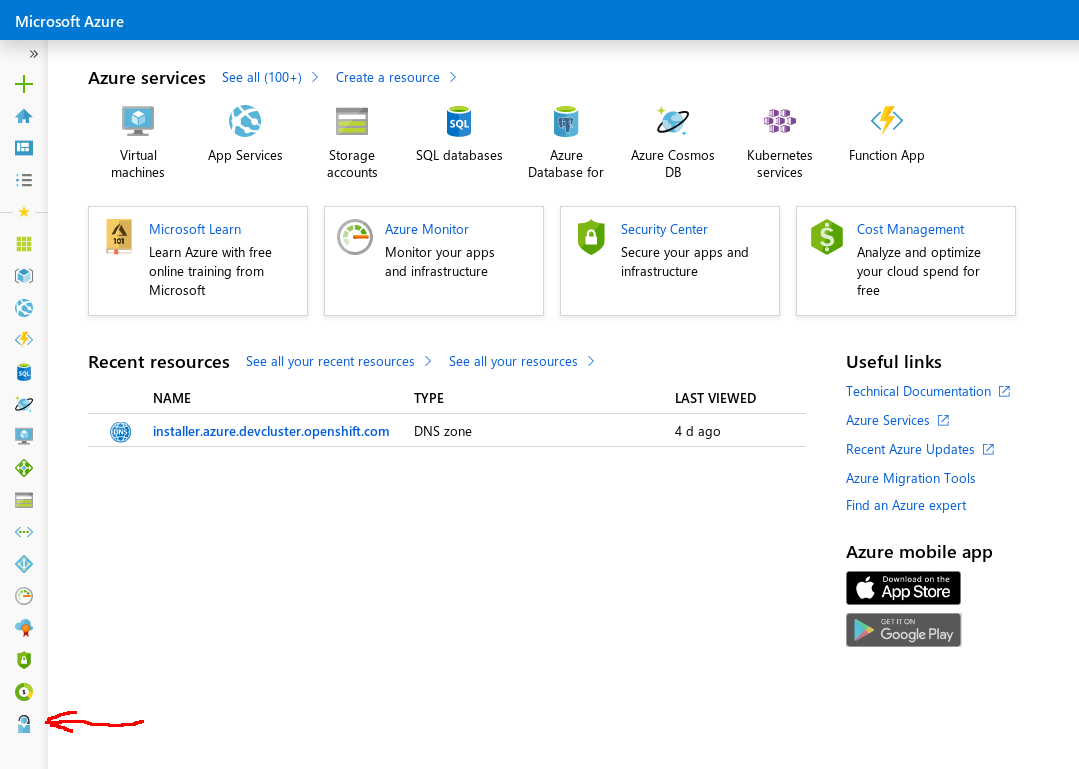 134 135 Next, click on "New support request" 136 137 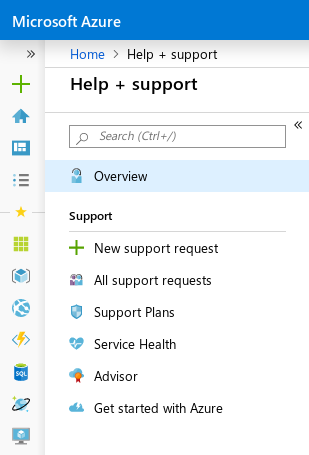 138 139 From here, you'll want to specify the issue type of "Service and subscription limits (quotas)" 140 141 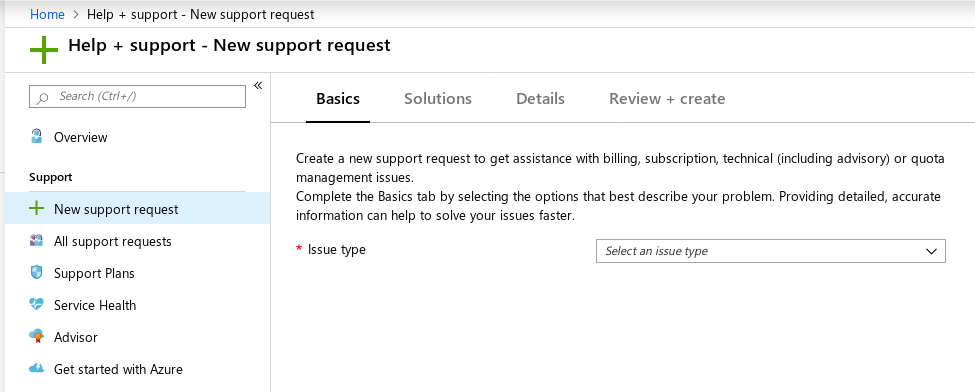 142 143 Pick the subscription you'll be updating as well as the quota type. 144 145 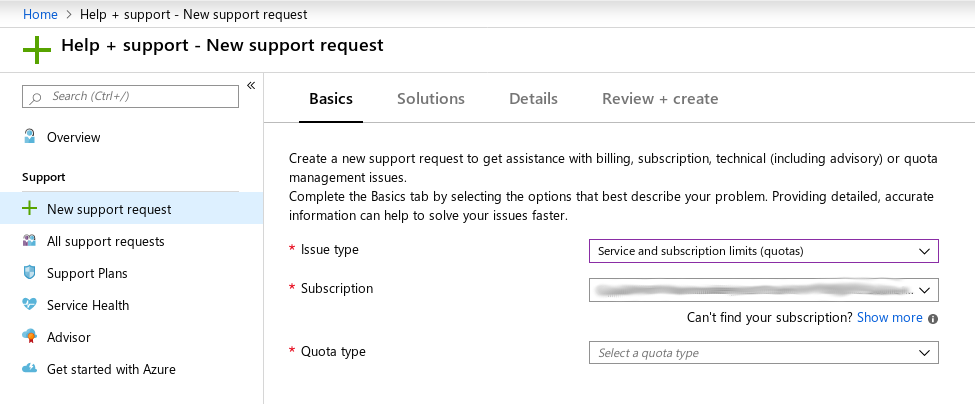 146 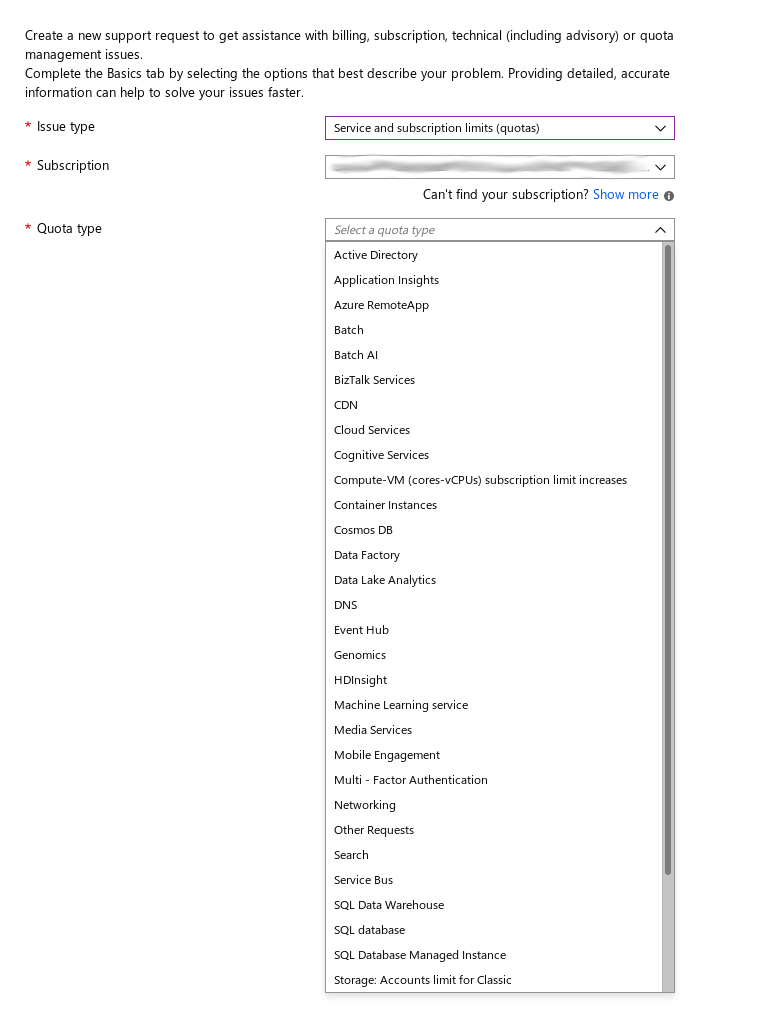 147 148 Once you've specified the subscription and quota type, you'll need to fill out your contact information. 149 150 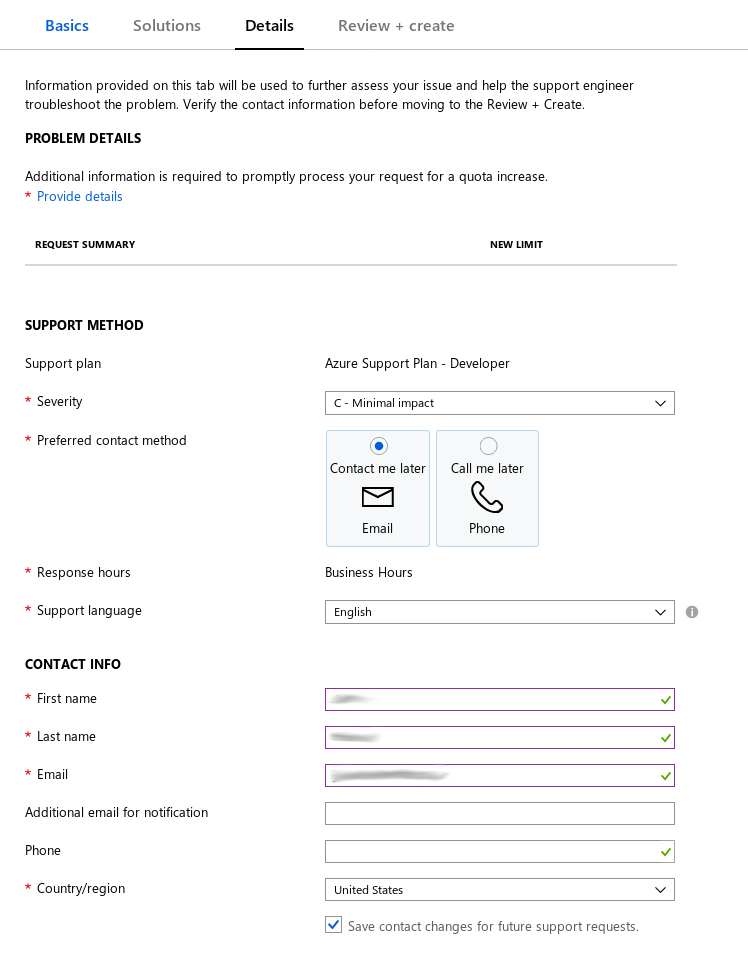 151 152 153 You will then review and submit your request. 154 155 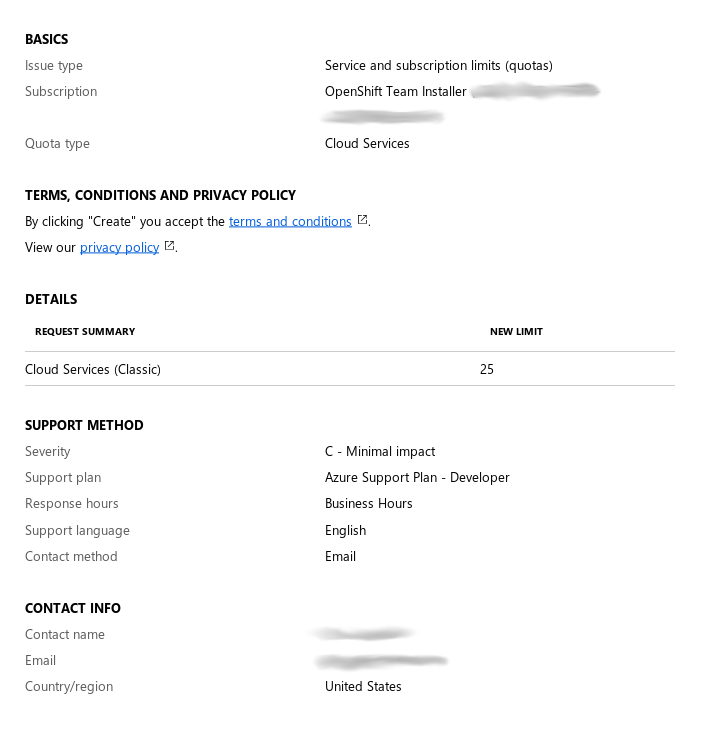 156 157 158 [availability-zones]: https://azure.microsoft.com/en-us/global-infrastructure/availability-zones/ 159 [az-map]: https://azure.microsoft.com/en-us/global-infrastructure/regions/ 160 161 [network-ip]: https://docs.microsoft.com/en-us/azure/virtual-network/virtual-network-ip-addresses-overview-arm 162 163 [load-balancing]: https://docs.microsoft.com/en-us/azure/load-balancer/load-balancer-overview 164 [service-limits]: https://docs.microsoft.com/en-us/azure/azure-subscription-service-limits 165 [sizes-general]: https://docs.microsoft.com/en-us/azure/virtual-machines/windows/sizes-general 166 [sizes-arm64]: https://docs.microsoft.com/en-us/azure/virtual-machines/dpsv5-dpdsv5-series